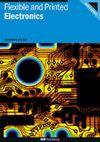通过家用熨烫提高柔性印刷电子织物导体的耐用性和电气性能
IF 3.2
4区 工程技术
Q3 MATERIALS SCIENCE, MULTIDISCIPLINARY
引用次数: 0
摘要
印刷导体的电气性能通常会随着时间的推移而降低,原因是经常或不经常暴露在弯曲和清洗等实际应力下。为了避免这种情况,需要一种修复机制来使导体恢复到最佳状态,从而在延长的应力周期内提高使用寿命和耐用性。在这项研究中,采用家用熨烫法修复和恢复因在标准熨烫温度下长时间弯曲和洗涤而受损的印刷导体的电阻。对两种聚氨酯涂层织物和粘附在织物上的六种不同层压板上的丝网印刷导体进行的可靠性测试结果表明,熨烫可显著提高导体的电气性能,在经过 400 000 次弯曲循环后,将电阻变化限制在 20% 以下,在经过 50 次水洗循环后,将电阻变化限制在 1 Ω 以下。虽然层压导体更耐用,其性能普遍优于印刷底层上的导体,但在这两种情况下,结果表明,样品可以放置 24 小时进行 "自我放松",也会恢复到原来的值,这意味着对于未来的穿着,无论是立即熨烫还是在两次使用之间放置一段时间,都可以有效地 "修复 "任何弯曲或洗涤损伤。本文章由计算机程序翻译,如有差异,请以英文原文为准。
Improving durability and electrical performance of flexible printed e-textile conductors via domestic ironing
The electrical performance of printed conductors often degrades over time due to recurrent or infrequent exposure to practical stresses such as bending and washing. To avoid this, a repair mechanism is required to return the conductor to prime condition, enhancing lifetime and durability during extended stress cycles. In this study, domestic ironing is used to repair and restore the electrical resistance of printed conductors damaged by prolonged bending and washing cycles at standard ironing temperatures. The results of reliability tests on screen-printed conductors on two polyurethane-coated fabrics and six different laminate sheets adhered to the fabrics revealed that ironing significantly enhances the electrical performance of the conductors, limiting the change in electrical resistance to less than 20% after 400 000 bending cycles and to less than 1 Ω after 50 wash cycles. Although laminated conductors are more durable and generally outperformed conductors on the printed primer layer, in both cases, the results showed that the sample could be left for 24 h for ‘self-relaxation’ and would also return to the original value, implying that for future wear, either immediate ironing or leaving the garment for a period between uses could effectively ‘fix’ any bending or washing damage.
求助全文
通过发布文献求助,成功后即可免费获取论文全文。
去求助
来源期刊

Flexible and Printed Electronics
MATERIALS SCIENCE, MULTIDISCIPLINARY-
CiteScore
4.80
自引率
9.70%
发文量
101
期刊介绍:
Flexible and Printed Electronics is a multidisciplinary journal publishing cutting edge research articles on electronics that can be either flexible, plastic, stretchable, conformable or printed. Research related to electronic materials, manufacturing techniques, components or systems which meets any one (or more) of the above criteria is suitable for publication in the journal. Subjects included in the journal range from flexible materials and printing techniques, design or modelling of electrical systems and components, advanced fabrication methods and bioelectronics, to the properties of devices and end user applications.
 求助内容:
求助内容: 应助结果提醒方式:
应助结果提醒方式:


